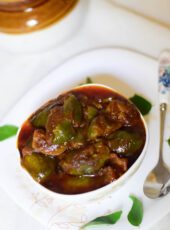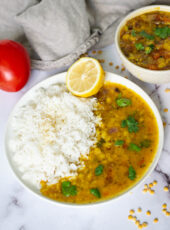Akkaravadisal is a rich and indulgent sweet dish made from rice, moong dal, and milk. It is very similar to sakkarai Pongal, except that the rice and dal are entirely cooked in milk. This Akkaravadisal recipe is an authentic recipe from Srirangam. Prepare Akkaravadisal this Margazhi and enjoy it with your family.

Margazhi is the 9th month in the Tamil Calendar year and begins in the mid of December and ends in the mid of January. Growing up, I have plenty of fond memories in the month of Margazhi. I usually had my Christmas and New Year holidays in the month of Margazhi. Mom and I would wake up before sunrise and walk to the temple.
History behind Akkaravadisal
The 27th day of Margazhi is known as ‘Koodaravalli’. Andal, one of the 12 Alwars has mentioned how to celebrate ‘Koodaravalli’ in her literary work called Thiruppavai. According to her, on this day, it would please Lord Krishna immensely if his devotees made a sweet dish called Akkaravadisal with oodles of ghee dripping from it and offer it to Him.

After a 26-day fast of depriving herself from eating ghee and milk, Andal breaks her fast on the 27th day with Akkaravadisal, after offering it to Lord Krishna. She mentions that the sweet dish Akkaravadisal should have so much ghee that it drips down your elbows when you take a handful of it. I can go on and on about the history, but let’s move on to the recipe.
Akkaravadisal involves cooking the rice and moong dal(lentil) mixture in milk, yielding a creamy and decadent base. This base is mashed and further cooked in more milk. Once the milk reduces a little, it is sweetened with jaggery and sugar and cooked with plenty of ghee. The end result is a decadent dessert, that will have you craving more.

The traditional recipe involves cooking rice-dal mixture in milk in a huge brass or clay pot over a firewood stove. It takes hours for the mixture to cook and reduce. However, it tastes absolutely divine. The smoke from the firewood or coal stove imparts a smoky flavor to Akkaravadisal. Let’s be honest, we don’t have the time to spend hours in the kitchen. Using a pressure cooker, cuts the cooking time by many folds.
Check out the other Indian desserts from my blog

This Akkaravadisal recipe
- Is an authentic recipe from Srirangam
- Tastes divine and decadent
- Takes half the time of the traditional stovetop method
- Will be a super hit with family and friends
Akkaravadisal – Ingredients
Raw rice
It’s best if you used raw white rice if you’re preparing this as an offering to Lord Krishna. If not, any type of white rice should work.
Moong dal
Moong dal when combined with rice gives a wonderful aroma. It is also known as Split petite yellow lentils.
Milk
I strongly recommend whole cow’s milk to get a rich Akkaravadisal. You can replace it with reduced-fat milk. Keep in mind that it won’t be as rich.
Saffron
Use good quality saffron for maximum flavor. Soak saffron in warm milk for 5 minutes before using.
Jaggery
Always melt jaggery and filter it before using it. If you’re sure that the jaggery you buy is of good quality, you can add it directly.
Sugar
Traditionally, a little sugar is added to sweeten Akkaravadisal. Sugar and milk caramelize together and give such a wonderful flavor to this dish.
Edible Camphor
Edible Camphor, also known as ‘Pacha Kalpooram’ is always added to all sweet offerings to Lord Vishnu. A pinch is enough to take the flavor to the next level.

Akkaravadisal – Method
Basic method
- Roast rice and moong dal and cook them in a pressure cooker with milk and water
- Meanwhile, melt the jaggery and filter it.
- Mash the cooked rice lentil mixture and cook it with more milk and ghee.
- Add the saffron, jaggery syrup, and sugar
- Finally, add cardamom powder, edible camphor and roasted cashews.
Akkaravadisal : Step-by-step method
Step 1: In a pan, add ghee and roast the cashews till they are golden brown. Take them out and set aside. Soak saffron in 2 tablespoons of warm milk and set aside.
Step 2: In the same pan, add moong dal and rice. Fry for 2-3 minutes, until a nice aroma, wafts from the moong dal.


Step 3: Add the roasted rice dal mixture along with 2 cups of milk and 1 cup of water to a vessel. Pressure cook it for 8-9 whistles.
Step 4: Meanwhile, melt the jaggery with 1/8th cup of water. Filter it and set it aside.


Step 5: Once the rice and dal have cooked well, mash the the mixture. Heat a pan, and add 3 tablespoons of ghee and the mashed mixture to it. Add 2 cups of milk and saffron soaked in warm milk. Mix well. Cook on medium-low for 10 minutes. Keep stirring every now and then to prevent burning.
Step 6: Add the jaggery syrup and sugar to it. Add 2 more tablespoons of ghee if desired. Cook for 10 more minutes till the mixture starts to thicken.


Step 7: Finally, add cardamom powder, edible camphor and roasted cashews to it. Then, mix well and remove from heat.


Akkaravadisal should be a little runny when you turn off the heat. However, it will thicken as it cools down. Serve it warm, topped with more ghee is desired.

Can I make Akkaravadisal with Non-Dairy milk?
I’m not sure if the non dairy milk will condense as well as cow’s milk. Akkaravadisal’s main flavor comes from the caramelization of milk. Using non-dairy milk will compromise on the taste and texture.
My Akkaravadisal is runny. What can I do?
Akkaravadisal is a little runny when you turn off the heat. It will thicken as it cools down.
How to store and re-heat Akkaravadisal?
You should promptly refrigerate the leftovers as it’s made out of milk. If you want to loosen the consistency while serving, re-heat it by adding hot milk and mixing it well. Top it up with more ghee for an instant flavor boost.
Akkaravadisal Recipe
Course: DessertCuisine: IndianDifficulty: Medium6
servings9
minutes30
minutesIngredients
Raw Rice – 1/2 cup
Moong Dal – 1/8th cup
Milk – 2 cups + 2 cups (divided)
Water – 1 cup
Ghee – 6 tablespoons
Jaggery – 1/2 cup ( 100 grams)
Sugar – 1/4 cup (60 grams)
Cardamon powder – 1 tsp
Saffron – 1/2 tsp
Edible camphor – a pinch (optional)
Directions
- In a pan, add ghee and roast the cashews till they are golden brown. Take them out and set aside.
- Soak saffron in 2 tablespoons of warm milk and set aside.
- In the same pan, add moong dal and rice. Fry for 2-3 minutes, until a nice aroma, wafts from the moong dal.
- Add the roasted rice dal mixture along with 2 cups of milk and 1 cup of water to a vessel. Pressure cook it for 8-9 whistles.
- Meanwhile, melt the jaggery with 1/8th cup of water. Filter it and set it aside.
- Once the rice and dal have cooked well, mash the the mixture.
- Heat a pan, and add 3 tablespoons of ghee and the mashed mixture to it. Add 2 cups of milk and saffron soaked in warm milk. Mix well. Cook on medium-low for 10 minutes. Keep stirring every now and then to prevent burning.
- Add the jaggery syrup and sugar to it. Add 2 more tablespoons of ghee if desired. Cook for 10 more minutes in medium-low till the mixture starts to thicken.
- Finally, add cardamom powder, edible camphor and roasted cashews to it. Then, mix well and remove from heat.
- Serve warm topped with more ghee.
Recipe Video
Notes
- Soak the saffron strands in warm milk for at least 10 minute for maximum flavor.
- Use whole milk for a creamier sweet. Low fat milk should also work, however it will not be as rich.
- Remove Akkaravadisal from heat when it is a little runny. It will thicken as it cools down to the right consistency.
- You have to use all that ghee to get the traditional flavor.
- If you jaggery does not have impurities, you can grate it and add it to the cooked mixture directly.
- Adjust the sugar according to your sweet preference.







Super. Explained in a simple way to understand and try themselves.
Thanks! 🙂
Yummy 😋
Thanks! 🙂